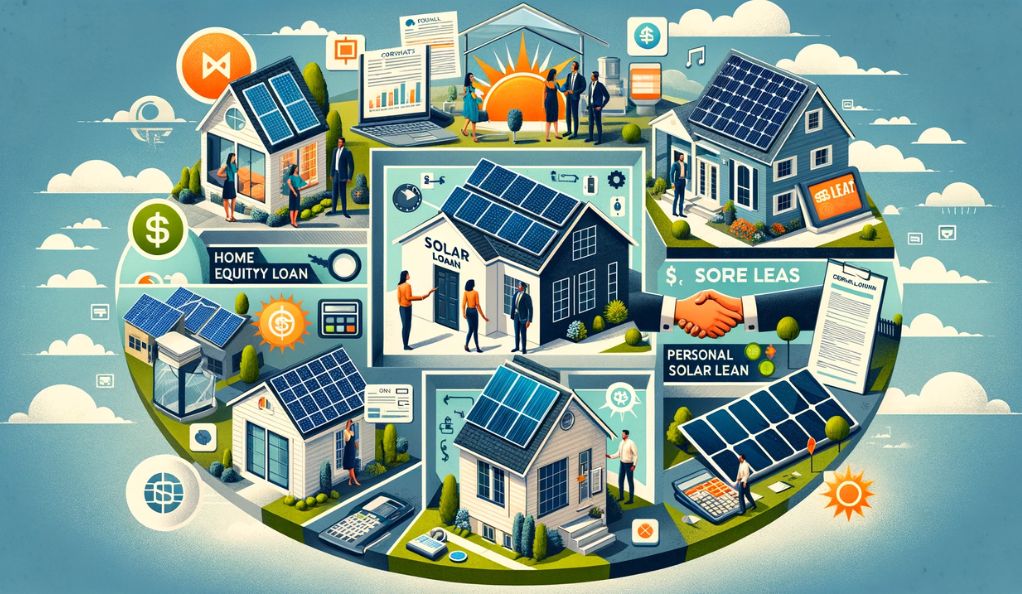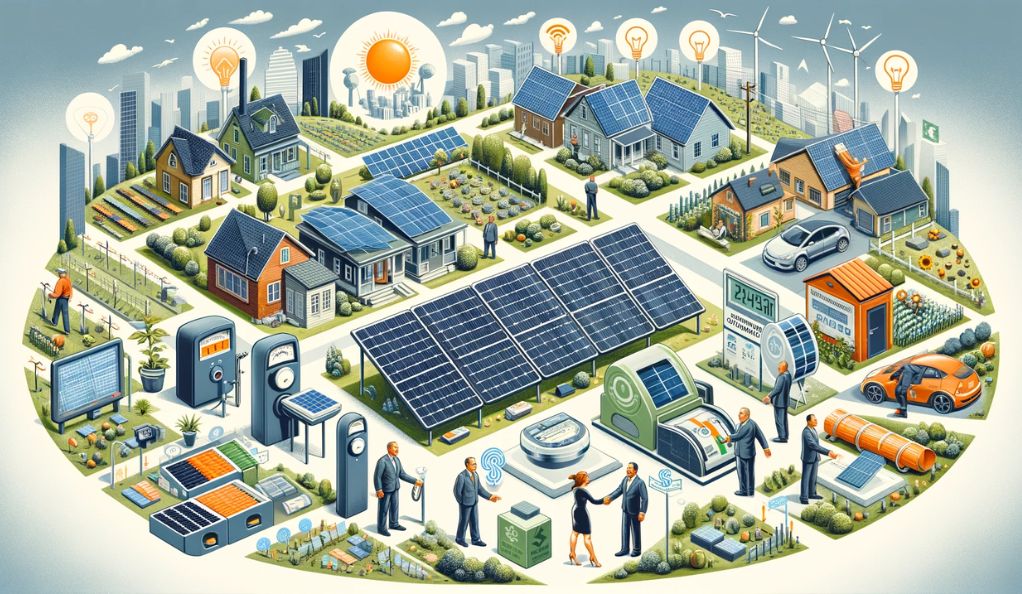As the world increasingly turns towards sustainable energy solutions, residential solar installations have become a cornerstone in the quest for a greener future. The allure of solar energy lies not just in its environmental benefits, but also in its potential to reduce long-term energy costs for homeowners. However, the upfront cost of solar installations can be a significant barrier. This is where solar financing comes into play, offering pathways to make solar energy a feasible and attractive option for a broader range of households.
The landscape of solar financing is diverse and ever-evolving, with options ranging from traditional loans to innovative financing models. Understanding these options is crucial for homeowners considering solar energy, as the right financing choice can significantly impact the overall cost and return on investment of solar installations.
The Rise of Renewable Energy and Solar Power
The shift towards renewable energy sources has been driven by both environmental concerns and advancements in technology. Solar power, in particular, has seen a dramatic reduction in costs over the past decade, making it more accessible to the average consumer. Governments around the world have recognized this potential and are offering various incentives to encourage the adoption of solar energy.
The Financial Challenge of Solar Installations
Despite the dropping costs, the initial investment in solar panels remains a hurdle for many. The typical cost of a residential solar system can range from a few thousand to tens of thousands of dollars, depending on the size and specifications of the system. This cost includes not only the solar panels themselves but also other components like inverters, batteries (if opting for a solar-plus-storage system), and installation fees.
Understanding Solar Loans
Solar loans have emerged as a popular financing option for homeowners looking to install solar panels. These loans work similarly to other types of home improvement loans but are specifically tailored for solar installations. The key characteristics of solar loans include the annual percentage rate (APR), monthly payments, fees, and the term length of the loan.
Annual Percentage Rate (APR)
The APR of a solar loan represents the total cost of the loan, including interest and any fees. It’s a crucial factor as it determines the overall cost of borrowing. Homeowners should aim for a loan with the lowest possible APR to minimize their total expenditure.
Monthly Payments
The affordability of monthly payments is as important as obtaining a low APR. It’s essential to ensure that the loan payments comfortably fit within your budget. Missed or late payments can have adverse effects on your credit rating.
Fees
Some lenders may charge origination fees, which are typically a percentage of the loan amount. This fee might be deducted from the total loan amount, affecting the funds you receive.
Term Length
The length of the loan repayment term is a critical factor. Loans with longer repayment terms usually have lower monthly payments but may accrue more interest over time, increasing the total cost.
Steps to Obtaining a Solar Loan
- Cost Estimation: Begin by comparing bids from multiple solar panel installation companies to understand how much you need to borrow.
- Calculating Payments: Use a solar loan calculator to find a suitable APR and repayment term that offers an affordable monthly payment.
- Rate Checking: Pre-qualification options from lenders can provide insight into potential loan rates, amounts, monthly payments, and repayment terms without impacting your credit score.
- Application Process: Once you accept a loan offer, prepare necessary documents like W-2s and tax documents to facilitate the application process.
- Funding: Upon approval, the loan funds are usually disbursed within a week.
Federal Solar Tax Benefits
A significant financial incentive for solar installations in the United States is the federal solar tax credit. This credit allows homeowners to deduct a percentage of the cost of installing a solar energy system from their federal taxes.
The Solar Investment Tax Credit (ITC)
The current federal policy provides a 30% tax credit for solar panel installations between 2022 and 2032. The credit will decrease to 26% in 2033 and 22% in 2034. This significant incentive not only reduces the initial financial burden but also encourages the adoption of solar energy.
How the Tax Credit Works
The tax credit is applied to the amount of tax you owe. For example, if you install a solar system costing $20,000, you could receive a $6,000 credit. It’s important to note that this credit is nonrefundable; it reduces your tax liability but won’t result in a refund if you owe less in taxes than the credit amount. Unused credit can be carried forward to future tax years, maximizing its benefit.
State-Specific Incentives
In addition to federal tax credits, many states offer their own incentives, such as additional tax benefits, rebates, and grants. Homeowners should explore these options to further reduce the cost of solar installations.
- Additional Tax Benefits: Certain states offer extra tax deductions or credits for solar installations.
- Rebates: Some states provide rebates which directly reduce the upfront cost of solar systems.
- Grants: In specific regions, grants may be available to cover a portion of solar installation expenses.
Different Types of Solar Loans

Understanding the variety of solar loan types is crucial for homeowners to make informed financing decisions. Each loan type offers distinct advantages and considerations.
Solar Company Financing
Some solar companies partner with third-party lenders to offer financing. These loans often require no down payment and might offer lower rates and longer repayment terms than personal loans.
Home Equity Loan
A home equity loan is another option for financing solar installations. These loans generally offer lower rates and longer repayment terms, as they are secured by your home. This makes them a less risky proposition for lenders.
Home Equity Line of Credit (HELOC)
A Home Equity Line of Credit (HELOC) is a flexible, secured financing option for homeowners. It allows the drawing of funds as needed, often with an interest-only payment option initially. This adaptability is beneficial for those with fluctuating financial needs. To maximize cost-effectiveness in solar financing, homeowners should diligently compare quotes and terms from various lenders, ensuring they choose the most suitable option for their unique financial circumstances.
Secured vs. Unsecured Solar Loans
Choosing between a secured and an unsecured solar loan depends largely on individual financial circumstances and risk tolerance.
Secured Loans
Secured loans are linked to collateral, usually home equity. This security for the lender typically means lower interest rates and more favorable terms. If payments are not made, the lender can claim the collateral. For homeowners with sufficient equity in their home and a willingness to use it as collateral, secured loans can be a cost-effective choice.
Unsecured Loans
Unsecured loans do not require any collateral. They generally pose a higher risk to the lender, which is often reflected in higher interest rates and less favorable terms compared to secured loans. For homeowners without sufficient equity or those not willing to risk their home, an unsecured loan may be a more suitable option, albeit typically more expensive.
Innovative Solar Financing Models
With the solar market’s growth, innovative financing options are increasingly available, making the process quicker and more streamlined.
New Financing Options
Companies such as Dividend, Mosaic, and Sungage Financial have revolutionized the solar financing landscape. They are dedicated to enhancing accessibility and efficiency in solar financing, offering innovative features like rapid credit evaluations and adaptable terms. These advancements are helping homeowners and businesses adopt solar energy more easily, contributing to a sustainable future.
Technology Integration
Aurora Solar, a cloud-based photovoltaic system design and sales software provider, has integrated with these new financing services. This integration reflects the industry’s move towards more user-friendly and efficient solar financing processes.
Alternative Solar Financing Options

Explore alternative solar financing options beyond traditional loans. Discover combo loans, reamortizing loans, and Property Assessed Clean Energy (PACE) programs that can make solar installations more accessible and affordable.
Combo Loans
Combo loans offer initial payments based on the net cost of the system, factoring in the solar tax credit. These loans are ideal for homeowners confident in their ability to claim the solar tax credit within a year.
Reamortizing Loans
Reamortizing loans allow a lump sum payment, like the solar tax credit, to restructure the loan and reduce monthly payments. This option is beneficial for those unsure of their tax liability or who prefer more flexibility in loan repayment.
Property Assessed Clean Energy (PACE)
PACE programs provide another alternative, where the loan is tied to the property rather than the owner. This can be a viable option in states where PACE is available, offering unique benefits in financing solar systems.
Conclusion
This article has navigated the varied landscape of financing options for residential solar installations, highlighting the importance of making an informed decision. From understanding solar loans and tax incentives to exploring innovative and alternative financing methods, homeowners now have a wealth of information to consider. The right financing choice can significantly ease the initial financial burden of solar installations, making sustainable living both attainable and beneficial. As solar technology advances and becomes more accessible, embracing solar energy not only contributes to a healthier planet but also offers long-term financial savings for homeowners.
